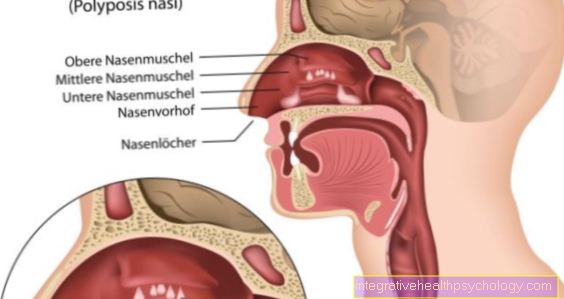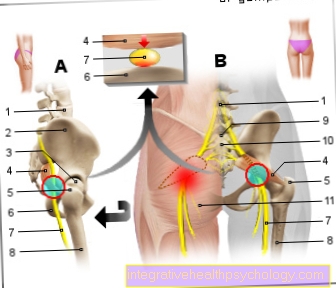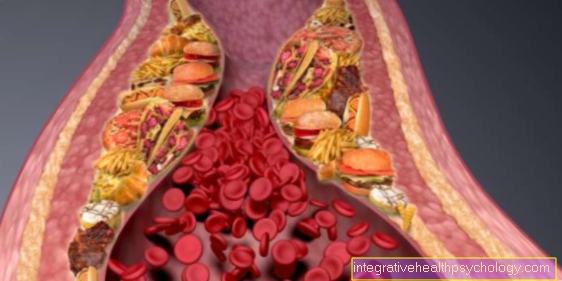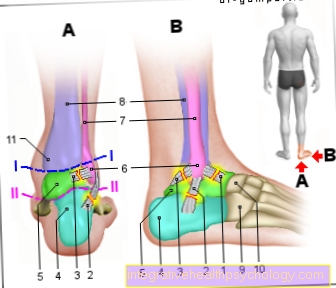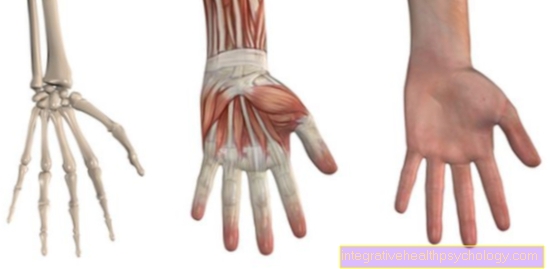mouth
Synonyms
Latin: Os, Oris
Greek: stoma
English: Mouth
definition
The mouth is a body cavity that, in addition to taking in food, is also responsible for forming the voice. It forms the upper part of the human digestive tract.
anatomy
The mouth is bounded by several structures. The front limit is determined by the Lips (Labia oris) and the rear by the Narrow throat (Isthmus faucium). Up and down put the palate (Palatum) and the Floor of the mouth (Diaphragm oris) represent a limitation. The lateral border is formed by the Cheeks (Buccae).
The space that is surrounded by these structures is called Oral cavity designated (Cavum oris). It is divided into the Oral vestibule (Vestibule oris), the Main cave (Cavitas oris propria) and the Throat - or throat tightness (Isthmus faucium).
The area between the cheeks, lips and Teeth designated. The lips form the entrance to the oral cavity. The execution courses of some Salivary glandslike that of the parotid gland (Parotid gland), as well as those of the smaller salivary glands (Glandulae labiales and glandulae buccales), open into the oral vestibule.
The main cave contains the tongue and the teeth, which serve to reduce the size of the food ingested. The function of the human oral cavity is to take in food and prepare it for subsequent digestion.
The mouth is of a special one Mucous membrane lined, which consists of a multilayered squamous epithelium. This multilayered squamous epithelium is mostly keratinized, but partly also keratinized.
microbiology
The human mouth is colonized by many different germs. The entirety of the microorganisms that accumulate in the mouth is known as Oral flora. It is a community of microorganisms that are involved in the digestive processes and in the the body's own immune system play a role.
The largest share is made up of various bacteria and Mushrooms. The composition of the physiological oral mucosa includes, among other things Actinomycetes, lactobacilli, neisseria and Streptococci.
A distinction is made between microorganisms that always colonize the mouth (resident oral flora) and those who are only there temporarily (transient oral flora).
Some bacteria can be responsible for the appearance of Caries to be responsible. The most common representative of the cariogenic germs is Streptococcus mutans. Other bacteria can Inflammation of the mucous membranes or also one Inflammation of the gums (Periodontal disease).
The microorganisms also play a large part in the development of Bad breath. The tongue has a large, very rough surface structure on which germs can settle particularly well. The bacteria decompose food residues left there and form a foul, sulphurous odor, which we call bad breath.
function
The mouth has many important functions. It plays an important role in breathing, eating, tasting and speaking. He also plays a significant role in the facial expressions and, apart from the eyes, embodies one of the most expressive parts of the face.
The mouth is important for taking in and chopping up food. It forms the entrance to the upper digestive tract. The teeth crush and grind the food ingested, and the enzymes released from the salivary glands begin to break down the food.
Then the food is transported further towards the throat via the tongue. The tongue has several important functions. In addition to the transmission of food, it is important for tasting, touching, swallowing and also for the formation of speech.
It is an elongated muscular organ that is covered by a mucous membrane. The taste buds, which are arranged on the entire back of the tongue, but are mainly located on the side edges and on the rear section, make it possible to perceive the different flavors sweet, bitter, salty, sour and umami.
In interaction with the nose and the larynx, the mouth is important for the formation and shaping of the voice.
The lips also have an important function. Their skin is very sensitive and irritable and they form an erogenous zone. When kissing, the stimuli are passed on to the brain, which releases certain messenger substances that can trigger feelings of happiness and desire.
Diseases of the mouth
Many different diseases can develop in the mouth. The most important are Inflammation of the lining of the mouth, abnormal process of teeth or tumors of the oral cavity.
The most common diseases are inflammatory processes that affect the oral mucosa such as Canker sores, Oral thrush, Inflammation of the gums or Cold sore.
Canker sores
Aphthae are inflammatory, painful changes in the lining of the mouth that often recur. The exact cause of the development is not known.
Allergic factors, minor injuries, infections or a lack of vitamins and minerals are seen as possible triggers.
The canker sores appear as round mucosal ulcers that are yellow-white in color and surrounded by a reddish area. They can be very painful, especially when they come into contact with foods that are very acidic.
Small canker sores can combine to form a large inflammatory ulcer that is very painful and can also make chewing and swallowing difficult.
We speak of three different forms. The minor type is most common with mucosal ulcers in the front part of the tongue that are a few millimeters in size.
In the major type, few ulcers develop, but they are larger than 1 cm, penetrate deep into the tissue and can be accompanied by swelling of the lymph nodes.
The herpetiform type is rather rare and is characterized by many small herds that look like herpes in their arrangement. For treatment, it is important to spare the affected areas and use a mouthwash to relieve the pain.
For more information, see: Canker sores
Oral thrush
The cause of the Oral thrush are Mushrooms. Mostly these are yeasts belonging to the genus Candida belong. The most common cause of infection is the oral mucosa Candida albicans. It develops in whitish coating on the oral mucosa, which can usually be easily scraped off with a toothbrush.
However, there can also be a large-scale infestation with thickened, large, whitish coatings, in the form of so-called Thrush plaques, to adjust.
The mushrooms find the best place to multiply on the Tongue surface, ill-fitting below Dentures or in Gingival pockets.
The fungal infection is not limited to individual sections, but can spread like a lawn over the entire oral mucosa. The oral thrush often occurs in patients with a weakened one immune system on, such as in children, the elderly, diabetics, patients with leukemia or a chronic disease or as a co-infection in patients with a HIV infection.
Also from taking certain medications, such as immunosuppressants, Antibiotics or cytostatics, the development of thrush is favored.
Oral thrush is treated with drugs that are directed against the fungi (Antifungal drugs). Often nystatin is used, which acts locally on the affected area in the form of gel or lozenges. Systemic therapy should only be considered in severe cases or if the fungus continues to spread to other organs.
For more information, see: Oral thrush




